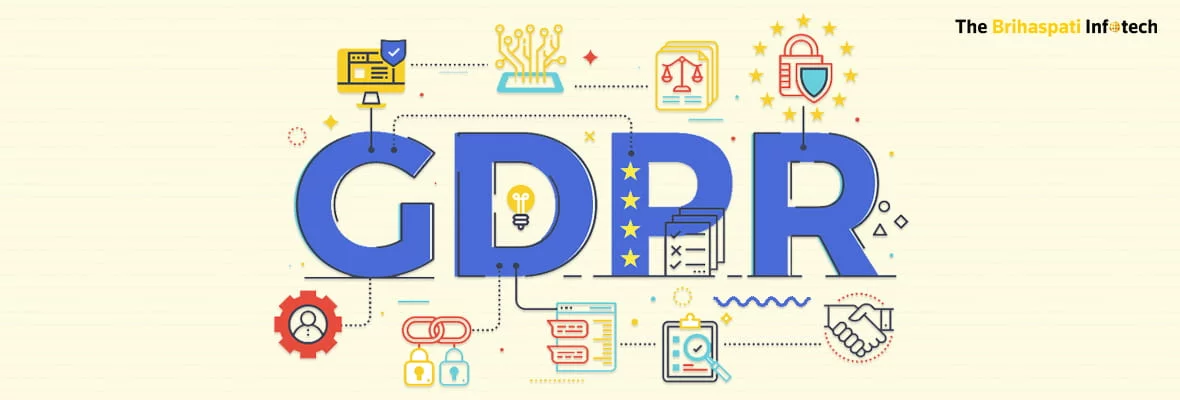GDPR Implementation: Key Insights To Privacy Driven Web Development

With the 25th of May looming on the head, the updated version of EU’s General Data Protection Regulation is currently eating up several working hours of online business leads. GDPR regulations promise enduring and effective laws for online businesses on how to collect user data in Europe and use it for advertising and analytics purposes.
What are GDPR Regulations?
GDPR is an updated version of existing EU laws aimed towards giving online users more control over the personal data they share with online service providers. In this process, business is required to be more explicit in the way they ask users to share their content and the process how they use the content.
What GDPR implementation means for businesses
- Re-consider the ways you’ve been collecting customer data, what was being collected and how it was being used.
- Obtaining personal data is not going to be a piece of cake.
- Any time you wish to collect personal data from a European citizen, you will need an explicit and informed consent from the user.
- Businesses will also need to provide a way for users to revoke that consent. This means users can anytime request all the data a company has on them in a primitive way in order to verify the validity of that consent.
- Users can even choose to revoke access to their personal information from the businesses anytime they wish.
- The new regulations are a lot stricter and have major consequences. Above all, they are applicable to online businesses around the globe who are dealing with European consumers.
- Break free from the old habits of collecting and sharing user data without keeping any restrictions in mind. It’s time to discover new approaches towards online user targeting and advertisement.
What happens if businesses ignore GDPR implementation?
Well, let’s say that this is the second most attractive aspect about GDPR and is catching the attention of businesses regardless of their sizes. If caught in violation of the GDPR legislations, companies could be fined up to 4 percent of its global turnover OR $20 million (whichever is larger).
This is enough motivation for any online business to play by the rules when it comes to data collection and privacy protection of their audience. While the rules are built for the protection of online users in the European Union, they are applicable to any business around the world who is serving these users.
While businesses have already started reviewing and rephrasing their data assortment and processing methods, privacy policies and terms of service documents and other warnings, there’s a lot for a business to be cautious of behind the scenes as well.
As one of the most competent web development company offshore with clients all around the globe (including the European Union), we have long observed the buildup to GDPR legislations and the best practices required for GDPR implementation in web applications.
In this article, we’ll explore everything a business needs to know about GPPR implementation in web applications and how to set up a privacy driven website which is GDPR compliant.
Note: We do not claim to provide any legal advice through this post.
GDPR Implementation: Key Insights for Privacy Driven Web Development
-
1. Design standards
GDPR implementation in web applications begins with a minimalistic design.
GDPR regulations are going to judge an application on multiple fronts if the application is data heavy. This also increases the chances of privacy concerns that can unintentionally lead to violations of GDPR standards.
Privacy protection at the design level can be attained by making sure only the absolutely necessary data is being stored and no personal data is being linked to another data set in a single location. In case it does, personal data identifiers should be avoided as much as possible.
-
2. Coding standards
Fortunately for web developers, GDPR guidelines do not favor or disfavor any particular development or testing tool. The development team just need to document the technology used in developing the application and present it if and when necessary to the GDPR officials.
In addition to this, developers must use preventive coding methods for GDPR implementation, i.e:
- Any outdated, unused or unsecured plugin should be disabled.
- Any outdated or insecure API’s should not be used.
- Privacy by design should be the derivative for analyzing whether or not a plugin is secure.
- Developers need to analyze what all personal data is captured by a plugin and whether or not there are any security concerns with the plugin in question.
- Code documentation should also include a mapping of data management: where it is captured, stored and encrypted.
-
3. Maintaining data transparency
Facilitating data, a key recital in the GDPR regulation is the ability for a user to download all the data a company has collected about the user over time. This allows users to verify that all data is collected and if it was done as per GDPR regulations.
Hence web applications preparing for GDPR compliance will need to provide the ability to users for providing all the data they have on them in a clear way.
-
4. Saving cookies will become challenging
With the rollout of GDPR regulations, it is expected that browsers will become the managers of user consent settings (at least for the users in Europe). This will allow users to explicitly define their cookie preferences within the browsers for each website they visit. Hence, if you are planning to target the European audience with cookies based advertisement banners, then you should start looking for better ways to persuade your audience for enabling cookies.
-
5. Elucidating consent forms
As users of web applications, how often have you filled up a form and missed out on checking the terms and conditions checkbox before submitting the document? With GDPR’s idea of consent, this will soon be transformed into multiple consent boxes that are clearly visible. On top of that, GDPR regulations demand that web applications list down the terms and policies in an easily understandable way. User Interface designs not taking this into account will certainly be considered as violators of GDPR policies.
-
6. Realizing what personal data to collect
A web application and it’s developers will have to realize what all data is considered as personal data in the GDPR regulations while developing functionalities that will use those data points. While earlier only the following points were considered as personal data:
- Racial or ethnic origin
- Political opinions
- Religious or philosophical beliefs
- Trade union membership
- Health data
- Sexual orientation
- Criminal convictions data
GDPR regulations have expanded its definition after considering technological advancements and new data points. These are:
- Genetic data
- Biometric data (such as facial recognition or fingerprint logins)
- Location data
- Pseudonymized data
- Online identifiers
These new data points includes are directly linked to:
- Mobile IMEI numbers
- MAC addresses
- IP addresses
- Browser history
- Cookies
- Fingerprints
- User account IDs etc. that identifies a user.
Web applications targeting the European audience will need to realize the new data available for aggregation and will have to plan their user interfaces, terms and privacy policies accordingly in order to prepare for GDPR.
7. Need of Privacy by design approach
The privacy by design approach has been a voluntarily used practice by web developers since its inception in 1990’s by Dr. Ann Cavoukian. It defines the design approach based on seven key principles which are:
- i. Privacy must be proactive, not reactive, and must anticipate privacy issues before they reach the user. Privacy must also be preventative, not remedial.
- ii. Privacy must be the default setting. The user should not have to take actions to secure their privacy, and consent for data sharing should not be assumed.
- iii. Privacy must be embedded into the design. It must be a core function of the product or service, not an add-on.
- iv. Privacy must be the positive sum and should avoid dichotomies. For example, PbD sees an achievable balance between privacy and security, not a zero-sum game of privacy or security.
- v. Privacy must offer end-to-end lifecycle protection by engaging the user in proper data minimization, retention and deletion processes.
- vi. Privacy standards must be visible, transparent, open, documented and independently verifiable.
- vii. Privacy must be user-centric and the interface must provide granular privacy options, maximized privacy defaults, detailed privacy information notices, user-friendly options and clear notification of changes.
With privacy being brought into the spotlight by GDPR regulations, Privacy by design principles will play a major role in GDPR implementation for web applications.
8. Privacy Impact Assessment (PIA)
GDPR recitals have also documented the need for Privacy Impact Assessment (PIA) for data-intensive projects. In GDPR Article 29 Working Party (WP29), there are documented guidelines on DPIAs which sets out the criteria that organizations should consider when determining the risks posed by a processing operation.
A Privacy Impact Assessment (PIA), is a methodology to discuss, audit and avoid privacy risks in the data collection and maintenance process. This document is a must have for data-intensive projects should always be maintained by the web application agency as an official data protection regulator can demand it in case of a data breach or a security concern in the web application.
Documenting a PIA is the key for GDPR implementation in a web application.
Every PIA document is to be built around the following details:
- i. Technical and security measures used in the application.
- ii. User access to the application.
- iii. User access rights within the application.
- iv. Legal obligations of the web application.
- v. Potential privacy risks in the web application and the measures are taken to avoid those risks.
Bottom Line
May 25 will certainly be a day of reckoning for web applications and a new dawn for how user privacy was being managed over the internet thus far. There is definitely a lot of confusion, revolt as well as praise among users with different viewpoints for GDPR. But the internet will not be the same for years to come once GDPR is launched.
We hope we were able to clear up the confusion regarding how web applications can be made compliant with GDPR standards. If there are further concerns or queries, then our expert team of web developers is always available to join hands and come up with robust solutions.

